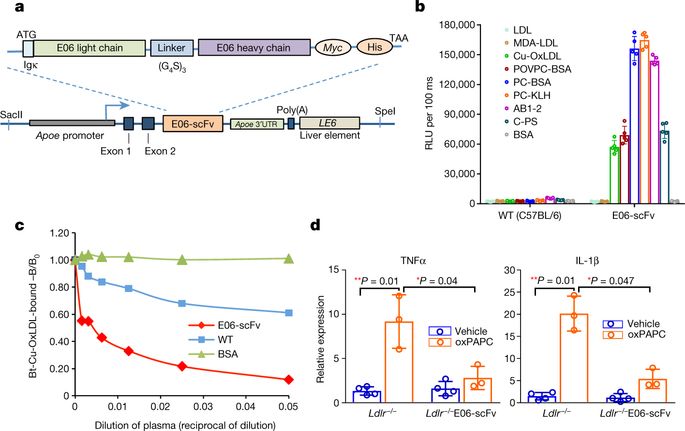Our official English website, www.x-mol.net, welcomes your
feedback! (Note: you will need to create a separate account there.)
Oxidized phospholipids are proinflammatory and proatherogenic in hypercholesterolaemic mice
Nature ( IF 50.5 ) Pub Date : 2018-06-01 , DOI: 10.1038/s41586-018-0198-8 Xuchu Que, Ming-Yow Hung, Calvin Yeang, Ayelet Gonen, Thomas A. Prohaska, Xiaoli Sun, Cody Diehl, Antti Määttä, Dalia E. Gaddis, Karen Bowden, Jennifer Pattison, Jeffrey G. MacDonald, Seppo Ylä-Herttuala, Pamela L. Mellon, Catherine C. Hedrick, Klaus Ley, Yury I. Miller, Christopher K. Glass, Kirk L. Peterson, Christoph J. Binder, Sotirios Tsimikas, Joseph L. Witztum
Nature ( IF 50.5 ) Pub Date : 2018-06-01 , DOI: 10.1038/s41586-018-0198-8 Xuchu Que, Ming-Yow Hung, Calvin Yeang, Ayelet Gonen, Thomas A. Prohaska, Xiaoli Sun, Cody Diehl, Antti Määttä, Dalia E. Gaddis, Karen Bowden, Jennifer Pattison, Jeffrey G. MacDonald, Seppo Ylä-Herttuala, Pamela L. Mellon, Catherine C. Hedrick, Klaus Ley, Yury I. Miller, Christopher K. Glass, Kirk L. Peterson, Christoph J. Binder, Sotirios Tsimikas, Joseph L. Witztum

|
Oxidized phospholipids (OxPL) are ubiquitous, are formed in many inflammatory tissues, including atherosclerotic lesions, and frequently mediate proinflammatory changes1. Because OxPL are mostly the products of non-enzymatic lipid peroxidation, mechanisms to specifically neutralize them are unavailable and their roles in vivo are largely unknown. We previously cloned the IgM natural antibody E06, which binds to the phosphocholine headgroup of OxPL, and blocks the uptake of oxidized low-density lipoprotein (OxLDL) by macrophages and inhibits the proinflammatory properties of OxPL2–4. Here, to determine the role of OxPL in vivo in the context of atherogenesis, we generated transgenic mice in the Ldlr−/− background that expressed a single-chain variable fragment of E06 (E06-scFv) using the Apoe promoter. E06-scFv was secreted into the plasma from the liver and macrophages, and achieved sufficient plasma levels to inhibit in vivo macrophage uptake of OxLDL and to prevent OxPL-induced inflammatory signalling. Compared to Ldlr−/− mice, Ldlr−/−E06-scFv mice had 57–28% less atherosclerosis after 4, 7 and even 12 months of 1% high-cholesterol diet. Echocardiographic and histologic evaluation of the aortic valves demonstrated that E06-scFv ameliorated the development of aortic valve gradients and decreased aortic valve calcification. Both cholesterol accumulation and in vivo uptake of OxLDL were decreased in peritoneal macrophages, and both peritoneal and aortic macrophages had a decreased inflammatory phenotype. Serum amyloid A was decreased by 32%, indicating decreased systemic inflammation, and hepatic steatosis and inflammation were also decreased. Finally, the E06-scFv prolonged life as measured over 15 months. Because the E06-scFv lacks the functional effects of an intact antibody other than the ability to bind OxPL and inhibit OxLDL uptake in macrophages, these data support a major proatherogenic role of OxLDL and demonstrate that OxPL are proinflammatory and proatherogenic, which E06 counteracts in vivo. These studies suggest that therapies inactivating OxPL may be beneficial for reducing generalized inflammation, including the progression of atherosclerosis, aortic stenosis and hepatic steatosis.A single-chain variable fragment of the antibody E06, which binds to the phosphocholine headgroup of oxidized phospholipids, blocks the uptake of oxidized low-density lipoprotein by macrophages, and reduces inflammation and atherosclerosis in hypercholesterolaemic mice.
中文翻译:

氧化磷脂在高胆固醇血症小鼠中具有促炎和促动脉粥样硬化作用
氧化磷脂 (OxPL) 无处不在,在许多炎症组织(包括动脉粥样硬化病变)中形成,并经常介导促炎变化1。由于 OxPL 主要是非酶促脂质过氧化的产物,因此尚无特异性中和它们的机制,并且它们在体内的作用在很大程度上是未知的。我们之前克隆了 IgM 天然抗体 E06,它与 OxPL 的磷酸胆碱头基结合,阻止巨噬细胞摄取氧化低密度脂蛋白 (OxLDL) 并抑制 OxPL2-4 的促炎特性。在这里,为了确定 OxPL 在体内动脉粥样硬化形成背景下的作用,我们在 Ldlr−/− 背景下生成转基因小鼠,使用 Apoe 启动子表达 E06 (E06-scFv) 的单链可变片段。E06-scFv 从肝脏和巨噬细胞分泌到血浆中,并达到足够的血浆水平以抑制体内巨噬细胞摄取 OxLDL 并防止 OxPL 诱导的炎症信号传导。与 Ldlr−/− 小鼠相比,Ldlr−/−E06-scFv 小鼠在 4、7 甚至 12 个月的 1% 高胆固醇饮食后动脉粥样硬化减少了 57-28%。主动脉瓣的超声心动图和组织学评估表明,E06-scFv 改善了主动脉瓣梯度的发展并减少了主动脉瓣钙化。腹膜巨噬细胞中的胆固醇积累和体内 OxLDL 摄取均减少,腹膜巨噬细胞和主动脉巨噬细胞的炎症表型均降低。血清淀粉样蛋白 A 减少 32%,表明全身炎症减少,肝脏脂肪变性和炎症也减少。最后,E06-scFv 延长了超过 15 个月的寿命。因为 E06-scFv 除了结合 OxPL 和抑制 OxLDL 在巨噬细胞中的吸收能力之外缺乏完整抗体的功能作用,这些数据支持 OxLDL 的主要促动脉粥样硬化作用,并证明 OxPL 具有促炎和促动脉粥样硬化作用,E06 在体内抵消. 这些研巨噬细胞摄取氧化的低密度脂蛋白,并减少高胆固醇血症小鼠的炎症和动脉粥样硬化。E06-scFv 延长了超过 15 个月的寿命。因为 E06-scFv 除了结合 OxPL 和抑制 OxLDL 在巨噬细胞中的吸收能力之外缺乏完整抗体的功能作用,这些数据支持 OxLDL 的主要促动脉粥样硬化作用,并证明 OxPL 具有促炎和促动脉粥样硬化作用,E06 在体内抵消. 这些研巨噬细胞摄取氧化的低密度脂蛋白,并减少高胆固醇血症小鼠的炎症和动脉粥样硬化。E06-scFv 延长了超过 15 个月的寿命。因为 E06-scFv 除了结合 OxPL 和抑制 OxLDL 在巨噬细胞中的吸收能力之外缺乏完整抗体的功能作用,这些数据支持 OxLDL 的主要促动脉粥样硬化作用,并证明 OxPL 具有促炎和促动脉粥样硬化作用,E06 在体内抵消. 这些研巨噬细胞摄取氧化的低密度脂蛋白,并减少高胆固醇血症小鼠的炎症和动脉粥样硬化。
更新日期:2018-06-01
中文翻译:

氧化磷脂在高胆固醇血症小鼠中具有促炎和促动脉粥样硬化作用
氧化磷脂 (OxPL) 无处不在,在许多炎症组织(包括动脉粥样硬化病变)中形成,并经常介导促炎变化1。由于 OxPL 主要是非酶促脂质过氧化的产物,因此尚无特异性中和它们的机制,并且它们在体内的作用在很大程度上是未知的。我们之前克隆了 IgM 天然抗体 E06,它与 OxPL 的磷酸胆碱头基结合,阻止巨噬细胞摄取氧化低密度脂蛋白 (OxLDL) 并抑制 OxPL2-4 的促炎特性。在这里,为了确定 OxPL 在体内动脉粥样硬化形成背景下的作用,我们在 Ldlr−/− 背景下生成转基因小鼠,使用 Apoe 启动子表达 E06 (E06-scFv) 的单链可变片段。E06-scFv 从肝脏和巨噬细胞分泌到血浆中,并达到足够的血浆水平以抑制体内巨噬细胞摄取 OxLDL 并防止 OxPL 诱导的炎症信号传导。与 Ldlr−/− 小鼠相比,Ldlr−/−E06-scFv 小鼠在 4、7 甚至 12 个月的 1% 高胆固醇饮食后动脉粥样硬化减少了 57-28%。主动脉瓣的超声心动图和组织学评估表明,E06-scFv 改善了主动脉瓣梯度的发展并减少了主动脉瓣钙化。腹膜巨噬细胞中的胆固醇积累和体内 OxLDL 摄取均减少,腹膜巨噬细胞和主动脉巨噬细胞的炎症表型均降低。血清淀粉样蛋白 A 减少 32%,表明全身炎症减少,肝脏脂肪变性和炎症也减少。最后,E06-scFv 延长了超过 15 个月的寿命。因为 E06-scFv 除了结合 OxPL 和抑制 OxLDL 在巨噬细胞中的吸收能力之外缺乏完整抗体的功能作用,这些数据支持 OxLDL 的主要促动脉粥样硬化作用,并证明 OxPL 具有促炎和促动脉粥样硬化作用,E06 在体内抵消. 这些研巨噬细胞摄取氧化的低密度脂蛋白,并减少高胆固醇血症小鼠的炎症和动脉粥样硬化。E06-scFv 延长了超过 15 个月的寿命。因为 E06-scFv 除了结合 OxPL 和抑制 OxLDL 在巨噬细胞中的吸收能力之外缺乏完整抗体的功能作用,这些数据支持 OxLDL 的主要促动脉粥样硬化作用,并证明 OxPL 具有促炎和促动脉粥样硬化作用,E06 在体内抵消. 这些研巨噬细胞摄取氧化的低密度脂蛋白,并减少高胆固醇血症小鼠的炎症和动脉粥样硬化。E06-scFv 延长了超过 15 个月的寿命。因为 E06-scFv 除了结合 OxPL 和抑制 OxLDL 在巨噬细胞中的吸收能力之外缺乏完整抗体的功能作用,这些数据支持 OxLDL 的主要促动脉粥样硬化作用,并证明 OxPL 具有促炎和促动脉粥样硬化作用,E06 在体内抵消. 这些研巨噬细胞摄取氧化的低密度脂蛋白,并减少高胆固醇血症小鼠的炎症和动脉粥样硬化。











































 京公网安备 11010802027423号
京公网安备 11010802027423号